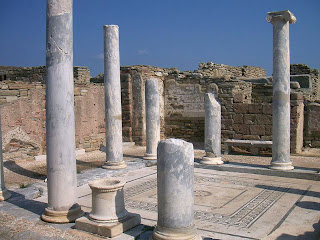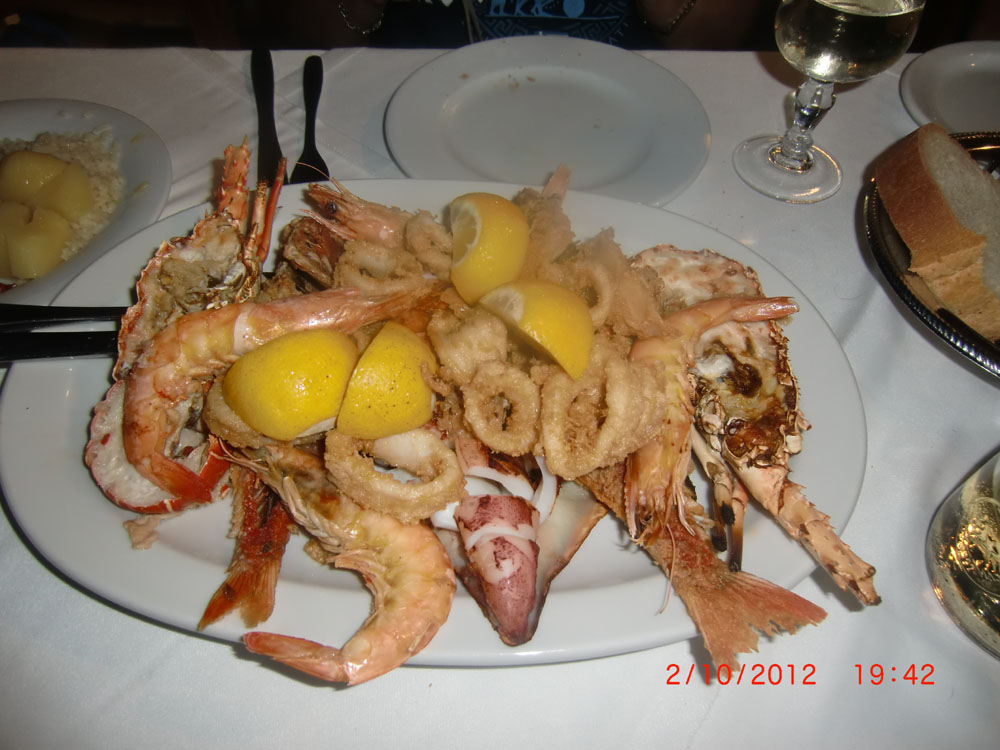October 2, 2012
The Greek Islands
Today we sail on the Aegean Sea to start our cruise to the Greek Islands.
Patmos
Our first stop is in Patmos (Greek, Πάτμος; Italian:
Patmo), a small Greek island, one of the northernmost islands of the Dodecanese complex. Visitors can see the cave where the apostle John is said to have received his Revelation (the Cave of the Apocalypse), and several monasteries on the island are dedicated to Saint John. Took the tender to walk in the town, climbed up a hill and found a small church where I saw a panoramic view of the town and the sea. The historic center (Chorá) with the Monastery of Saint John is a UNESCO World Heritage Site.
Delos
We continued sailing and arrived in Mykonos mid-afternoon. We immediately took the tender to take the Delos tour. The island of Delos (Greek: Δήλος), near the center of the Cyclades archipelago, is one of the most important mythological, historical and archaeological sites in Greece. The excavations in the island are among the most extensive in the Mediterranean. Delos had a position as a holy sanctuary for a millennium before Olympian Greek mythology made it the birthplace of Apollo and Artemis.
Mykonos
Returning to Mykonos (Greek: Μύκονος), part of the Cyclades, we had a great seafood dinner then managed to walk around the touristy town before taking the last tender back to the ship.
October 3
Lindos
Arrived in the island of Rhodes after breakfast and got ready for the shore excursion to Lindos and the city of Rhodes. Lindos (in Greek: Λίνδος) is an archaeological site and was founded by the Dorians led by the king Tlepolemus of Rhodes, who arrived in about the 10th century BC. It was one of six Dorian cities in the area known as the Dorian Hexapolis. Above the modern town rises the acropolis of Lindos, a natural citadel which was fortified successively by the Greeks, the Romans, the Byzantines, the Knights of St John and the Ottomans. Some of the impressive sights here are the Doric Temple of Athena Lindia, dating from about 300 BC; the Propylaea of the Sanctuary, also dating from the 4th century BC; the Hellenistic stoa with lateral projecting wings, dating from about 200 BC; the well-known relief of a Rhodian trireme (warship) cut into the rock at the foot of the steps leading to the acropolis; the Hellenistic staircase (2nd century BC) leading to the main archaeological area of the acropolis; remains of a Roman temple, possibly dedicated to the Emperor Diocletian and dating from about 300 AD; the Castle of the Knights of St John, built some time before 1317 on the foundations of older Byzantine fortifications; the Greek Orthodox Church of St John, dating from the 13th or 14th century. Some scenes of the well-known film,
The Guns of Navarone, were filmed here.
Rhodes
Rhodes (Greek: Ρόδος,
Ródos) is the principal city on the island of Rhodes an island in the Dodecanese. Rhodes has been famous since antiquity as the site of Colossus of Rhodes, one of the Seven Wonders of the World, and has been used in many poems, the most famous being Shakespeare's Julius Caesar. The citadel of Rhodes, built by the Hospitalliers, is one of the best preserved medieval towns in Europe which in 1988 was designated as a UNESCO World Heritage Site.
Went back to the Louis Cristal to get my backpack then went to town and the beach. Passed by the area where the Colossus of Rhodes stood. Had fun on the beach but the water was quite cold.
October 4
Heraklion
Heraklion (Greek: Ηράκλειο) is the largest city and the administrative capital of the island of Crete, Greece. Disembarked with Marleen and Gary and checked out the city which was in the middle of some kind of demonstration with a lot of cars honking their horns. Checked out some shops before returning to the ship.
Santorini
Back on board we sailed towards the last island and highlight of our Greek Islands tour. Santorini (Greek: Σαντορίνη), is an island in the southern Aegean Sea. It is essentially what remains after an enormous volcanic explosion that destroyed the earliest settlements on a formerly single island, and created the current geological caldera. We took a tender and then a bus to visit the beautiful town of Oia.
Back on the ship, I had a nice dinner with Marleen and Gary at the private restaurant THALASSA while we sailed to Piraeus in mainland Greece.
TO TO VIEW THE NEXT PORTION OF THE TRIP, PLEASE CLICK ON MAINLAND GREECE IN THE BLOG ARCHIVE BELOW.































































No comments:
Post a Comment